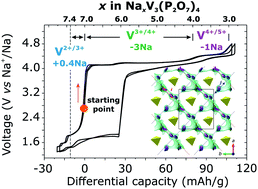Na7V3(P2O7)4 as a high voltage electrode material for Na-ion batteries: crystal structure and mechanism of Na+ extraction/insertion by operando X-ray diffraction†
Abstract
The crystal chemistry and the electrochemical properties of Na7V3(P2O7)4 as a high voltage cathode material upon Na+ extraction/insertion were investigated. The crystal structure was solved and refined for the first time from single crystal X-ray diffraction data. Possible sodium migration pathways were determined using the bond valence energy landscape (BVEL) method based on the bond valence theory. The electrochemical behavior of the material in a wide voltage range demonstrates the activity of the V3+/V4+, V4+/V5+, and V3+/V2+ redox couples. The reversible capacity of the Na7V3(P2O7)4 electrode is hence increased up to 118 mA h g−1vs. Na+/Na. Sodium extraction/insertion mechanisms are examined by operando X-ray diffraction, which provides direct information on the evolution of the material in nonequilibrium states upon electrochemical oxidation and reduction processes.



 Please wait while we load your content...
Please wait while we load your content...